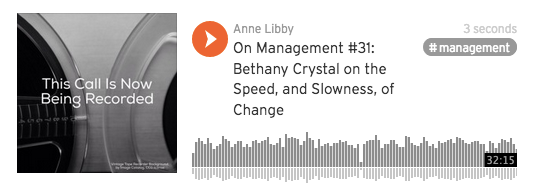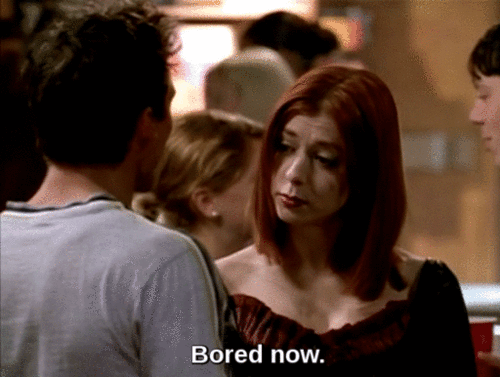Slowness, Speed and Structure: On Management #31
One of my common refrains: people management is a “thing.” When I say this, I mean that management is a discipline. It’s characterized by basic behaviors, actions, and responsibilities.
There’s a structure to it all.
Now via Substack, and a Process Point
If you’re reading this, sometime in the last 3 years, you opted in to receive my newsletter. If its arrival is a surprise, I hope it’s a pleasant one.
My newsletter used to hit inboxes via Mailchimp, bearing my personal email address. Gmail and corporate IT powers-that-be may have sorted it to spam or promotions. I’m now on Substack and a bit nervous about how this will go.
Down the road, I’m also wondering what more Gmail could do to affect newsletter deliverability. Please do add people@substack.com to the list or filter that deposits this email where it belongs, for you.
A Hierarchy of Needs — At Work

In 2017 I listed some of our basic human needs at work. An ability to manage our lives outside of work. An understanding of what’s expected of us, and how we’ll be treated. Membership in a community, recognition, and professional growth.
PSA: when you lead people, this tough news cycle is yours to lead people through. (And that goes for any difficult changes in your own office, or industry.)
Managers influence conditions that affect team members’ lives — at work, and at home. In this way, you change the world in very real and meaningful ways.
Cartoon artist Jason Li graciously made this illustration.
Audio: Bethany Crystal, Union Square Ventures
I spent some time last week teaching myself about the rollout of another complex, largely agreed-upon system — the driving rules of the road. I was curious to see if there was anything we could glean from how the transformative innovations of the auto industry impacted how we agreed upon basic signage, rules, and protocols that we still use today. - Bethany Crystal, A brief history of the adoption of the rules of the road
Bethany Crystal’s article sparked me to reflect on the constant process of agreement about the “signage, rules and protocols” of people management. I was curious about her perspective.
Bethany is GM of the portfolio network at Union Square Ventures, where she works to connect the 8,000 people in USV portfolio companies with knowledge, resources, and one another.
This month’s audio is from our August conversation. We discussed communication, trust, and how leaders can help people to face change. Especially when things are always happening fast. And the evolution of how the startup/tech community views “management.”

- Here’s Bethany’s article: A brief history of the adoption of the rules of the road (And what we can learn from this for regulating new technologies today)
- When you want something to happen or exist in the physical world, it’s complicated! Here’s the Sara Chipps article I mentioned: So you want to build a hardware company, and you’re a software engineer...
- Like all of my audio, this conversation has been edited. Mostly to remove ums, errs, weird crackling noises, and (my) lengthy expositions, cul-de-sacs, and lead-ins to questions.
A Bit More About Structure
When there’s a pile of clothes on the floor of your closet, it’s hard to see the difference between your gorgeous St. John topper and the sweater you picked up at Uniqlo.
When you put your clothes on hangers, they’re more accessible, useful*. Your wardrobe makes more sense.
The structures, protocols, and processes for people management can serve the same function.
When designed well, and used well, process adds visibility and support to important elements of your workplace relationships. Like hangers.
This is also true, and relevant, as we enter performance review season. If you haven’t started already, take a look at when reviews are due. Then, reverse-engineer your way to making them as meaningful as possible.
*I’m a nut for attribution, and I’m pretty sure that this metaphor isn’t completely mine. I’ve been binge-listening to podcasts, and hope to uncover who else I’ve heard talking about hangers. I’ll report back.
Winning at New Manager Training: Mission Possible
So, you’re going to a manager training. You may/may not be stoked. How can it be a success? Spoiler alert: set some goals, for yourself.
That said, let’s start with your organization’s goals.
Here’s a not-secret about management development programs.
The list of skills you need to learn, and master over time, is not long. On theme with my chat with Bethany Crystal: this list is not evolving terribly fast.
This stuff is not brain surgery.
“Setting mission-aligned goals, using 1:1s to create relationship and accountability, giving actionable feedback, developing and coaching team members, and so forth.” (- one of my own recent descriptions of best practices *)
When your bosses send you to training, tbh, they aren’t always thinking about where management development fits into the organization’s strategic goals.
They’re thinking about how much time. How much money.
And they hope. They hope you’ll learn the practices and processes of management.
Mostly, they hope you will change.
There is a space between what you’re already doing, and what they hope. This gap can look like a performance shortfall. This may/may not be fair.
Mind the gap.
Your mission, should you choose to accept it: figure out how you need to change. Because training won’t “install” a gap-fixer on you. You’ll have to do some work, with your community, by practicing.
1. Inquire. Ask your boss, your team members, “I’m setting goals for what I need to learn in manager training. What do you suggest?”
You may not get a good answer. Persevere.
Unearth feedback about your performance as a manager. Are there results from employee engagement surveys? Your last review?
You may need to read between the lines. Persevere.
Form a hypothesis about what you want to do differently after completing the training. Share this with others. Ask for feedback; revise as necessary.
2. Prepare. Preview the subject matter to be covered. Consider how the topic comes into play in your work. Develop questions around each topic.
Decide what you want to learn. Write it down. Share, ask for feedback, revise.
3. Engage. Use the instructor: bring your questions with you. Ask them.
Take notes, by hand.
Unless there’s an unfolding family emergency, stow your devices during the session(s), and mute your notifications.
4. Integrate. After the session, review your notes. What was new, or surprising? What do you disagree with?
What are your questions, now? Write them down.
Discuss your questions with a peer, your boss, or another manager in your life. (Hi, mom.)
The most important question: what will you put into action, in your work, starting today?
5. Mind the gap. If one could learn to manage people in a classroom, every MBA would be a great manager. #truth
So if you didn’t learn what you wanted to learn, it might be because you have to practice, in real life.
Or maybe you weren’t stoked, and tried to look like you were taking notes on your laptop. No shame, no blame.
Review your notes and materials from the training again. Get some direction from a manager or a mentor.
What can you put into action, right now? Figure this out, and then start to practice.
And, a literal P.S. I’m adding the following point on October 5.
And you know what, maybe being a manager isn’t for you. You would not be the first.
Maybe you took the promotion, without understanding that the job requires a lot of previously invisible work. It just might not be for you. That’s not your failure.
The failure would be to continue along in the role, faking it. You’ll be miserable, and so will your team members. This is one of those “call a lifeline” career moments. Talk this one through with someone you trust.
Question
When a workplace structure seems like it’s not helpful, what can you learn?
Links
- In case I haven’t told you, Sue Shellenbarger is a national treasure. When You Fear Your Company Has Forgotten Its Principles.
- The Trust Battery: My Interview with Shopify Founder Tobi Lütke [The Knowledge Project Ep. #41] It took me a few days to listen to this Shane Parrish podcast. It’s long. And it blew me away. Synchronicity: the discussion shared some themes with my audio this time. And there was thoughtful discussion about reading. (If anyone on this list is in the Shopify universe, I would love to interview Tobi. Just about what, why and how he reads.)
- In March, 2017, I sat down on my living room sofa, and opened up Voice Memos on my iPhone 4s. My hacky audio is about managing the elements of my hierarchy of workplace needs, especially during a nightmare news cycle. (Yes, I’ve upgraded my phone.)
- Structure, in and of itself, doesn’t solve problems. Marines Move to Tackle Racial Extremists in the Corps, by Rahima Nasa at Propublica.
From my various ’verses…
- Call for Product Managers, Engineering Managers, and Designers. Peer relationships can provide a mutually beneficial structure for professional growth. Gary Chou knows how to convene and engage peer cohorts. Check and join Orbital's Fall 2018 Studios.
- We must explore why our structures mute, downgrade, and repel some of the human beings in our orbit. To do so, we must listen, and hear. Seattle-area women of color share how they navigate the workplace, by Ruchika Tulshyan at the Seattle Times.
- Our use of the word “senior” can be, um, unstructured. Alex Jones is writing, thinking, and iterating on What it Means to be “Senior”.
- You Are What You Read is Jane Watson’s case for newsletters as a way to structure your inputs, as an antidote to awashness in media. She also recommended newsletters, a couple of which were new to me. (And gave me a nice shout-out!)
Thank you for reading, and welcome to new readers who found me via Twitter, Substack, and Jane Watson’s Talent Vanguard. Thank you, Jane Watson!
I appreciate Bethany Crystal, the staff at The Launch Pad (where I recorded this month’s audio), and artist Jason Li, for making (at least) one of my ideas much better.
Thanks also to the good people at Substack who endured a ton of questions from me as I’ve made this transition. (S/O to the kind and responsive Hamish McKenzie.)
Bye,

(I had originally picked an Ethan Hunt gif for my closer. Then, I just couldn’t even.)




